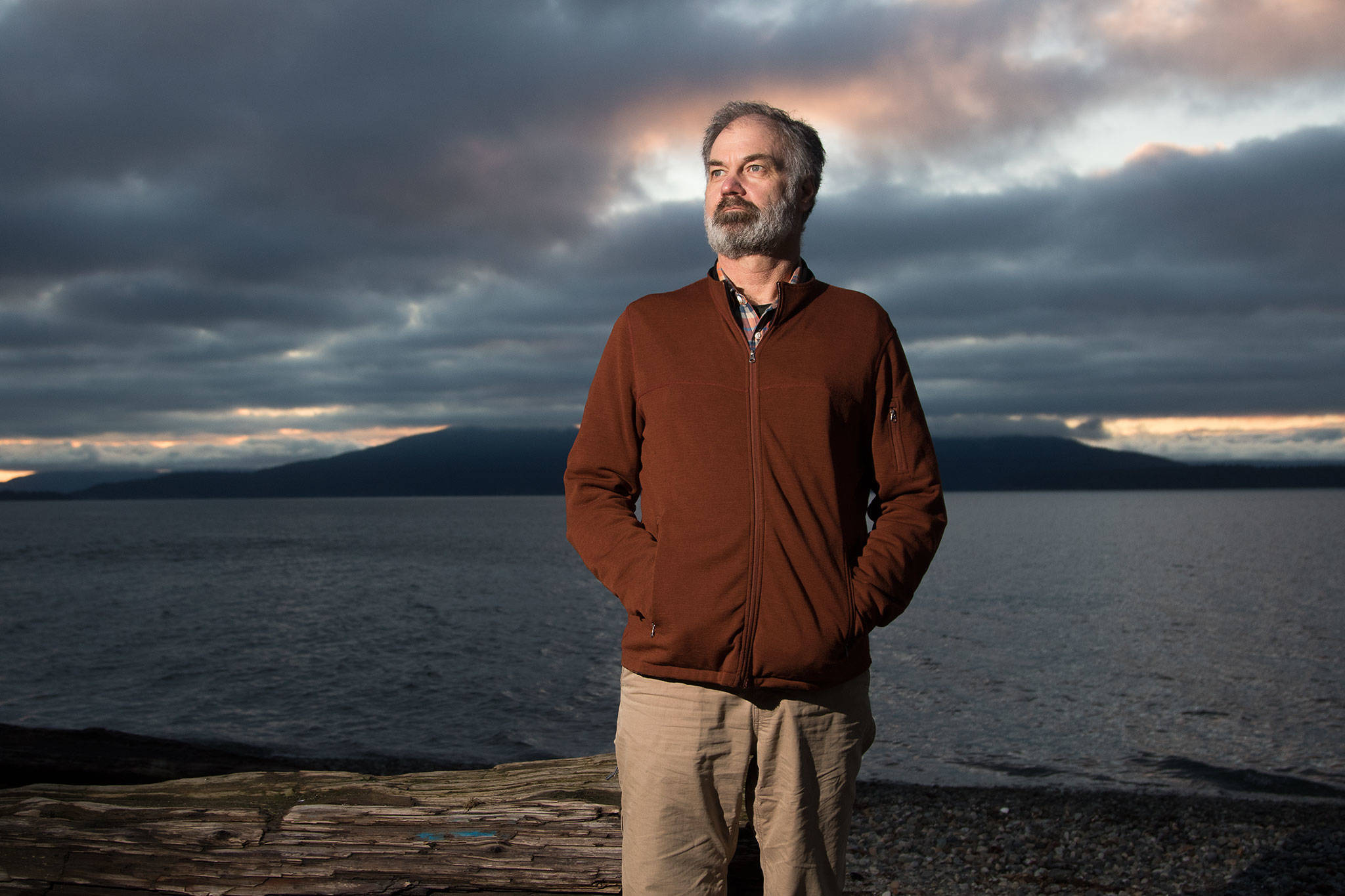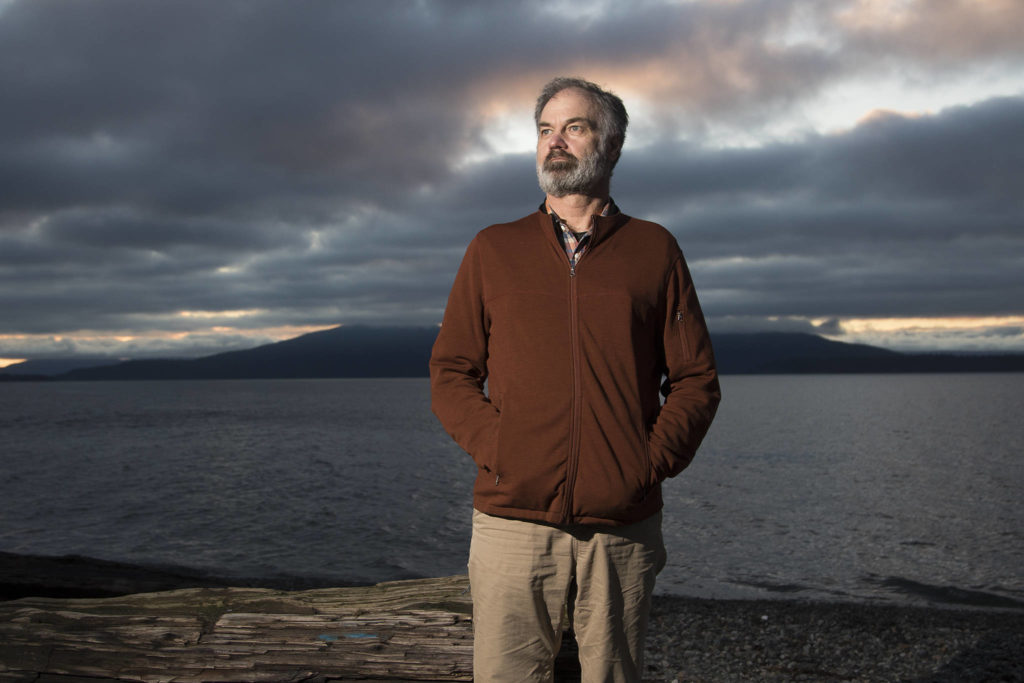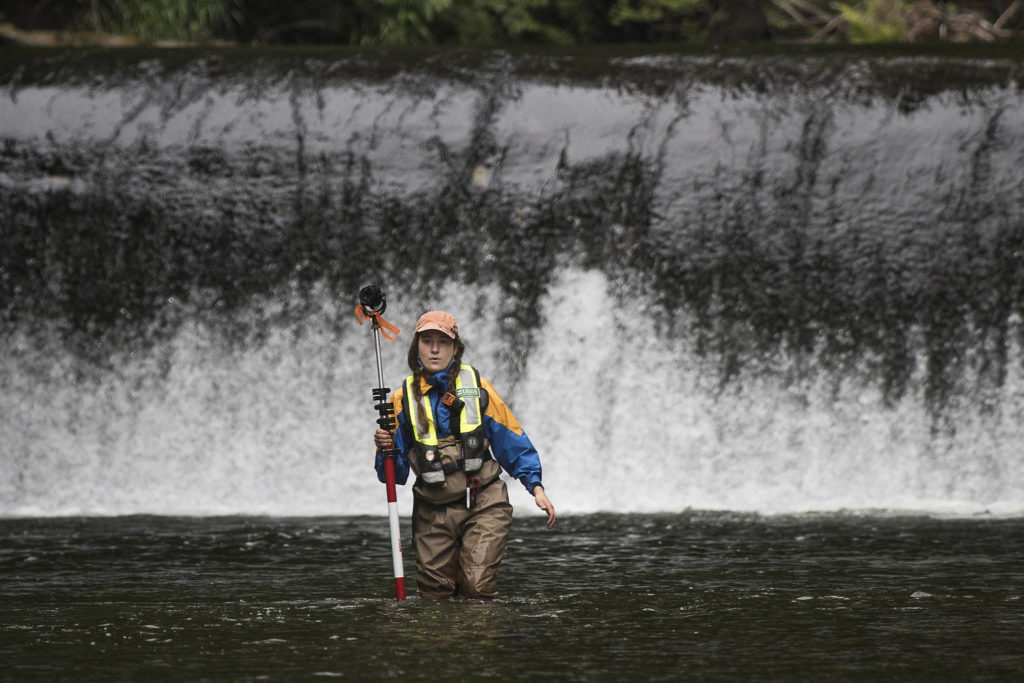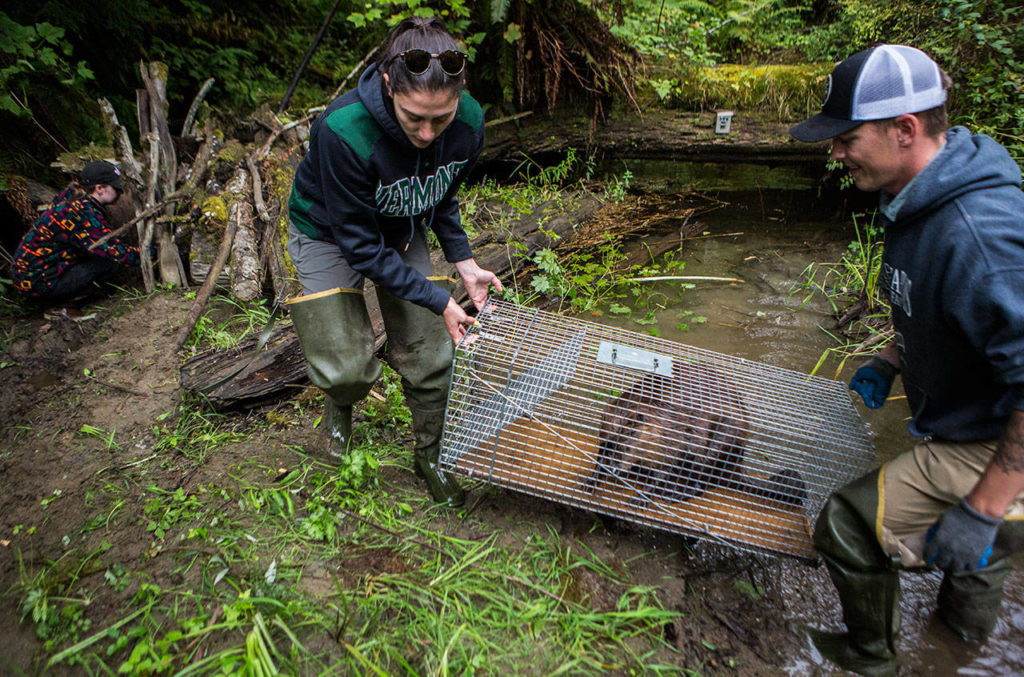TULALIP — When Terry Williams grew interested in climate change in the 1970s, he found information about human-caused global warming to be conflicting and confusing.
“It didn’t make sense until the early ’80s, when we saw a difference in the timing of the floods,” the Tulalip Tribes elder recalled. Later studies bore out what was happening in the tribes’ traditional lands. “The glaciers were melting two to three months early. We got floods in November and December instead of March and April. Rainfall had increased 6%.”
The 5,000 enrolled Tulalip citizens are primarily from the Snohomish, Snoqualmie and Skykomish tribes. In three river systems with the same names, ever-bigger and earlier floods wash away salmon eggs or bury them in river sediment. Higher water temperatures may kill fish that do manage to hatch. They never make it to Puget Sound.
If salmon can’t survive, what will happen to a Native culture based on a plentiful supply?
That question is one that drives the Tulalip Tribes’ intense interest in adapting to and slowing climate change. Williams, 72, helped lead the fight for four decades until his retirement in July as head of the Tulalips’ Treaty Rights Office, which he founded. He passed the torch to Ryan Miller, 33.
“If we lose these species that are so intrinsically connected to who we are, we lose part of ourselves,” said Miller, who as a teenager worked at the tribal fish hatchery where his father, Richard, ran the water quality lab. “It’s already difficult to pass on these traditions in modern societies. As these resources get more scarce, it becomes more and more difficult.”
Miller is director of treaty rights and governmental affairs. The new job title reflects the sovereign nation’s engagement with the world well beyond its 35-square-mile reservation and its more than 9,000 square miles of ancestral lands.
Long active in climate-related efforts at the county, state, national and even international level, the Tulalips have ramped up activities in the past four years. The tribes formed a Climate Adaptation Team in 2016. Two Natural Resources Department staff members, Phil North and Aaron Jones, devote full time to climate issues. More hires are planned.
North is climate adaptation coordinator and conservation scientist. A non-tribal member, he previously worked 28 years for the Environmental Protection Agency, mostly in Alaska. Jones, of Snoqualmie descent, was raised in Tulalip and earned a master’s degree in public administration in 2016. As a treaty rights protection specialist, his responsibilities include maintaining online information at nr.tulaliptribes.com/Topics/ClimateChange.
The website is key to the tribes’ climate strategy. It serves in lieu of a formal planning document that quickly would be outdated, North explained. “We decided instead to accumulate our activities online and change that as we go.”
The strategy focuses on five geographic areas: the reservation coast, on-reservation forests, off-reservation forests, the Quil Ceda Creek watershed and the Snohomish River estuary.
On the reservation coast north of Everett, sea level rise and increased storm intensity threaten homes, infrastructure and habitat. The tribes have already torn down houses that were sliding down eroding hillsides to Mission Beach. Facilities at Tulalip Bay, including a sewage treatment plant, could be at risk. One study estimated that Puget Sound has risen nine inches in the past 100 years, North said. Ongoing research aims to predict future storm intensity; results are due in late 2021.
On-reservation forests face increased risk from fire, which could destroy foods, medicine and craft materials that are basic to tribal culture. Fire is among the threats covered in an updated hazard mitigation plan, which the tribes will send to the Federal Emergency Management Agency in January for approval. Like so many Washington residents, people on the reservation live near or in the woods, complicating firefighting and forest management.
In writing the hazard mitigation plan, tribal staff relied on climate history provided by the University of Washington Climate Impacts Group. While there is evidence of rare catastrophic fires in the region, there is little information about historic tribal management of the forests, North said. Human-ignited, low-intensity fires may well have reduced larger conflagrations.
Off-reservation forests include millions of acres of wildlife habitat, salmon-bearing streams and plant resources that are at risk from a changing global environment. This is where tribal rights afforded under the 1855 Treaty of Port Elliott come into play.
“Most people don’t realize that the tribes didn’t really give up those ceded lands — they basically agreed to share them. So, the future of that territory is of great concern to them,” North said. “The land has been very mismanaged for the last 170 years. The tribes are active stewards.”
Stewardship includes rebuilding landscapes so they will bounce back from fires and floods. Resiliency is a goal of many Tulalip projects. The tribes work with farmers to keep manure out of waterways, creating clean energy in the process. Staff have relocated nuisance beavers that would build salmon-friendly, water-storing forest ponds. Last summer they helped remove a Pilchuck River diversion dam that has blocked salmon migration for 118 years.
The Quil Ceda watershed, which includes Marysville, will see more floods thanks to changing storm patterns and continued development. The Tulalips’ climate strategy highlights this part of Snohomish County because its reservation is at the downstream end of Quil Ceda Creek, where flooding intensifies. The Tulalips are about to open a second casino near the confluence of the meandering creek and the Snohomish River’s wide Ebey Slough.
The Snohomish River Estuary, where saltwater and freshwater mingle, is critical to salmon. The tribes’ climate change strategy acknowledges that sea level rise will change wildlife habitat and raise groundwater levels on the reservation. It potentially could expose hazardous materials at a former riverside landfill, which was capped as part of a federal Superfund cleanup.
The Tulalips will investigate climate change impacts beyond the landscape, such as community health. The World Health Organization has identified risks from wildfires, extreme heat, air pollution and infectious diseases. Indigenous populations face increased risks, according to the EPA.
The Tulalips are also studying water sustainability, which Miller said would be an increasing issue in the next two decades.
“We have complicated Western water law, and we’re seeing the drought season get longer and longer,” he said. “The population is growing. How are we going to sustain that development with a reduction in water? We already don’t have enough water in the rivers, enough water for salmon.”
A 2019 survey of tribal members showed overwhelming concern about the impacts of climate change on animals and plants like salmon, orcas and huckleberries. That’s important information for Jones. His job, which is funded by the Bureau of Indian Affairs, is to educate people about climate change and what the tribes are doing about it. He knows it can be a polarizing topic.
“We want to introduce the science around it, so people can frame their own opinion,” he said. “We want to make people feel they like they can do something about it.”
School lesson plans about climate change will be created by staff at the Hibulb Cultural Center, where the education curator happens to be Jones’s mother.
“We hope to help students understand and continue efforts to protect our salmon, cedar and other natural and cultural resources from the risks and effects of climate change,” said Lena Jones. She noted that the cultural center already has relevant exhibits such as Cedar, Environment, and Protecting Our Traditional Knowledge.
Meade Krosby, a senior scientist with the UW Climate Impacts Group, is working with the Tulalips to determine the impacts on tribally important plants. The Tulalips have been leaders in organizing meetings, conferences and workshops around climate change, she said.
“They appear to be doing the hard and necessary work of mainstreaming climate change across a range of activities,” she said.
The Tulalips’ work is part of a national groundswell of tribal climate change efforts. A Bureau of Indian Affairs climate assessment map highlights hundreds of them; the University of Oregon’s Tribal Climate Change Project also keeps track.
The Affiliated Tribes of Northwest Indians launched its own climate change project in 2014. With Northwest tribal input, UW researchers created an online tool that regional tribes use to assess their vulnerability to climate change. Krosby, who led the project, appreciates the leadership that Native Americans are bringing to climate change.
“The tribes are on it,” she said. “And they’ve been on it — not just adaptation, but mitigation, too.”
Mitigation means reducing the greenhouse gases that are driving climate change. There is only so much that tribes can do about that, said Miller, the treaty rights director.
“The reality is, we have to come together as a country, as a species, to reduce carbon emissions,” Miller said. “Without that, nothing else we do will preserve our culture as it is today — whether it’s tribal culture, or the larger culture of human society.”
Northwest tribes threw their weight behind Washington’s Initiative 1631, which would have increased gasoline taxes and spent part of that revenue on landscape restoration. Voters defeated the measure in 2018.
“That was a difficult pill to swallow for me personally, because I worked hard on it,” Miller said. “And now we’re running out of time.”
That urgency is echoed by Terry Williams. He bemoans the Trump administration’s antagonism to climate change efforts over the past four years.
“We’re wasting time, critical time. We have to be ready to hit the ground running” when president-elect Joe Biden takes office, said Williams, who, despite his official retirement, is still hard at work. A member of the Pacific Salmon Commission, he is starting a salmon migration and ocean habitat mapping project.
Tulalip Tribal Chairwoman Teri Gobin, now 63, recalls 50-pound king chinook being hauled onto the beach in seine nets. As late as the 1990s, it was possible for fishermen like her father, late tribal leader Stan Jones, to make a living from the sea. Back then, Puget Sound orcas had more chinook to eat, too. Those resident killer whales are in danger of starvation.
Despite devastation of the fishery, Gobin finds reason for optimism. Even about climate change. She is excited about the potential for solar energy on the reservation.
“There are lots of programs out there to help us,” she said. “We could retrofit government buildings, possibly tribal housing. We’re talking about having a solar field.”
Gobin finds cause for hope in the resiliency of nature. She cited the Pilchuck Dam removal, which gave salmon access to 37 miles of spawning habitat. Within a couple of months, coho and chinook were spotted upstream of the former dam site.
Gobin is also buoyed by the trust that non-Indians are putting in the Tulalips.
“We’ve had people donating land back to tribe because they know we will fix it. They know we’ll clean up streams and restore shoreline,” she said. “We are the ones they come to, to help get stuff get done.”
Julie Titone is an Everett writer who can be reached at julietitone@icloud.com. Her work is supported by the Herald’s Environmental and Climate Reporting Fund.
Environmental reporting fund
This story was made possible by donations to The Daily Herald’s Environmental and Climate Change Reporting Fund. Contributions to the fund are tax-deductible and help pay for the local journalism that is essential to a vibrant community.
The fund, established in cooperation with the Community Foundation of Snohomish County, provides an opportunity to support environmental and climate change reporting in The Herald newsroom.
The Daily Herald maintains editorial control over content produced with fund resources.
Talk to us
> Give us your news tips.
> Send us a letter to the editor.
> More Herald contact information.





























